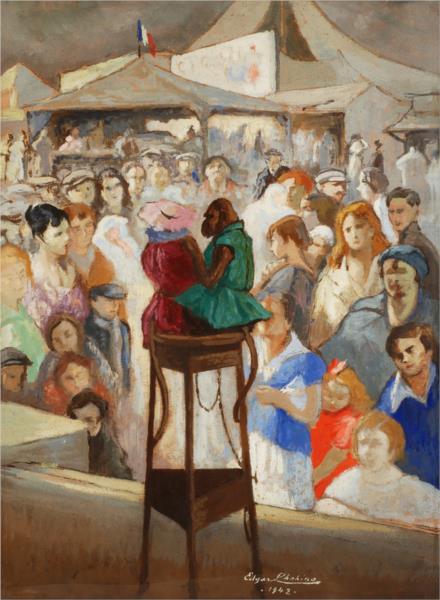Opis
The work "The Monkeys at the Fair", created in 1942 by Edgar Chahine, is set in a time when art is approaching playfulness and the observation of everyday life. Chahine, a notable exponent of modern art, is known for his ability to capture the essence of circumstances and characters, using the technique of engraving and painting to explore themes ranging from popular culture to urban life. In this canvas, the scene takes place in a festive environment, where two monkeys, central figures of the composition, are presented in a display of vivacity.
The composition reveals a fascinating interplay between the monkeys as protagonists and their surrounding environment, where descriptive elements can be seen that add a visual narrative. The artist employs a color palette that evokes a celebratory atmosphere: warm hues such as yellows and oranges, contrasted by deeper shadows that provide volume and dynamism to the figures. The texture seems to vibrate with the effervescent energy of the fair, capturing the viewer's attention with its luminosity and the way the colors intertwine.
The monkeys, represented anthropomorphically, carry with them a rich symbolic charge. Their playful behavior and curious expression not only suggest a commentary on the relationship between humans and animals, but also serve as a metaphor on human nature and its legacy of frivolity and frivolity in recreational spaces. The work retains a naive yet profound air, challenging the viewer to reflect on the essence of fun and spectacle.
Chahine demonstrates his mastery of space, making use of a composition that guides the eye across the canvas. The shapes interrelate in a way that recalls the nature of fairs, where different elements coexist in an ordered chaos. The balanced arrangement of the monkeys, one closer to the viewer than the other, creates a sense of depth and perspective that invites exploration.
Chahine's style, which often incorporates elements of influences such as Post-Impressionism and Fauvism, is manifested in the reduction of detail in favor of emotional expression and color. This aspect simplified visual analysis, giving priority to the impact that the image generates on the viewer. His works, moreover, reflect his observation of everyday life, a hallmark that is also visible in "The Monkeys at the Fair." This painting, like many of his contemporaries, can be seen as a celebration of the moment, an echo of the joys of social life in a period marked by tension.
Armenian-born Edgar Chahine, a key figure in French avant-garde art, continues to influence contemporary artists with his exploration of the human condition. In this sense, "The Monkeys at the Fair" is more than a simple representation; it is a reflection on being in the present and enjoying the ephemeral. This work invites us to contemplate not only the technique and color, but the life experience that frames the festive aesthetic and the nature of fun in the sociocultural context of its time. With a focus on the interaction between art and reality, Chahine reminds us of the importance of joy and curiosity inherent to the human being.
KUADROS ©, a famous painting on your wall.
Hand-made oil painting reproductions, with the quality of professional artists and the distinctive seal of KUADROS ©.
Painting reproduction service with satisfaction guarantee. If you are not completely satisfied with the replica of your painting, we will refund 100% of your money.

